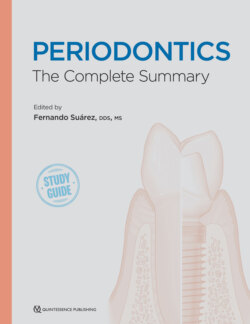Читать книгу Periodontics - Fernando Suarez - Страница 34
Radiographic Interpretation
ОглавлениеClinical periodontal examination provides information with regard to PDs, recession defects, AG/KG, and more; however, it cannot reveal the status of the alveolar bone. The alveolar bone is another critical aspect to take into consideration to accurately diagnose different periodontal diseases and conditions.2 Dental radiographs are the most commonly used noninvasive method of examining alveolar bone levels. Other valuable information that can be obtained through radiographic examination includes subgingival calculus deposition, root length and form, crown-to-root ratio, presence of periapical lesions, periodontal ligament space, root proximity, and the destruction of alveolar bone.2,7
Clinicians should keep in mind the following limitations of conventional dental radiography when interpreting radiographs during the examination phase3,7,25:
Radiographs do not show periodontal pockets.25
Radiographs cannot distinguish between posttreatment periodontitis and active periodontitis.25
Radiographs do not show buccal and lingual aspects of tooth and alveolar bone.25
Radiographs cannot detect tooth mobility.25
Radiographs can provide evidence of past destruction to the periodontium, but they cannot identify sites with active or ongoing periodontal inflammation.7
Clinical attachment loss always precedes visual radiographic changes by approximately 6 to 8 months, and clinical attachment variations are greater than radiographic changes.26
Radiographic changes are detectable by simple visual inspection when approximately 30% to 50% of the bone mineral has been lost.27
The presence or absence of the crestal lamina dura is another common interpretation of radiographs for diagnosing periodontitis. Rams et al28 observed that the presence of intact crestal lamina dura is positively correlated to periodontal stability over a 2-year follow up period. However, no significant relationship could be found between future periodontal breakdown and lack of crestal lamina dura.28 A recent publication by Rams et al also reported similar findings and concluded that patients with angular bony morphology and PD greater than 5 mm poses a significant risk of periodontitis progression after treatment. However, if intact crestal lamina dura is present, despite the bony morphology, clinical stability for at least 24 months can be anticipated.29 Also, molar furcation involvement can sometimes be observed on radiographs. Hardekopf et al were the first to describe the radiographic features of maxillary molars with furcation destruction: a triangular radiographic shadow, commonly known as “furcation arrow,” can be noted over the mesial and distal proximal areas of maxillary molars.30 The clinical reliability of the presence of furcation arrow can be subjective and also greatly dependent on the degree of destruction. For instance, when furcation arrows are present on radiographs, these can only predict actual furcation invasion 70% of the time. On the other hand, when there is true furcation involvement, a furcation arrow is seen in less than 40% of the sites.31 It has been reported that the presence of furcation arrow for diagnosing furcation involvement on maxillary molars has a low sensitivity (38.7%) and high specificity (92.2%).31 When mandibular molars suffer from furcation involvement, radiolucency can be noted at the area where roots start to separate.
In recent years, the utilization of CBCT has been rapidly increasing in popularity. CBCT has become an integral tool for researchers and clinicians, mostly applied to the implant field. As such, the use of CBCT imaging for the diagnosis of periodontitis has also been studied. However, in 2017, the American Academy of Periodontology reported that even though its use may be beneficial in selective cases, there is limited evidence to support the use of CBCT for the different types of bony defects, and there are no guidelines for its application to periodontal treatment planning.32
